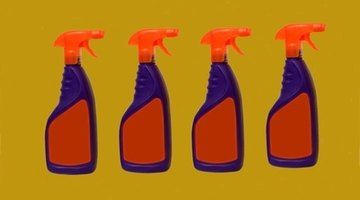How to Use Ammonia to Clean a Garden Sprayer

Garden sprayers are used to apply chemicals such as herbicides and pesticides to plants. After each use, a sprayer should be rinsed and cleaned to prevent buildup from forming inside the equipment and to prevent different chemicals from mixing together. Ammonia is an ideal cleaning product for oil-based chemicals such as 2, 4-D, sulfonylurea, dicamba and plant growth regulators. It works by raising the pH of the rinse, as well as binding to the residue and making it more soluble.
Step 1
Put on rubber or latex gloves. Empty the sprayer of pesticide or herbicide by pumping it out completely in an outdoor area that's away from animals and desirable plants. Spread it over a wide area so it won't concentrate in one spot. Don't pour it down a drain.
Step 2
Rinse the tank with clean water. Pump some water through the nozzle to clean it out, then pour out the water.
Step 3
Fill the pump sprayer with 1 cup of ammonia for every 3 gallons of water. Spray some of the ammonia solution through the nozzle to clean the inside. Allow the solution to sit in the sprayer for 18 to 24 hours.
Step 4
Spray some of the ammonia solution through the nozzle after the soaking time is complete. Pour out the ammonia, and rinse the tank with clean water several times. Pump some of the water through the nozzle to flush it out.
Step 5
Allow the pump sprayer to air dry in a well-ventilated area.
Warning
Don't pour pesticides or herbicides down a drain.
Warning
Don't use ammonia for wettable powder, amine forms or water-soluble chemicals. These require flushing the tank for several minutes with a commercial tank cleaning detergent at a rate of 2 pounds of detergent per 30 to 40 gallons of water, followed by a double rinse.
Things You Will Need
- Rubber or latex gloves
- Ammonia
References
Writer Bio
Shelley Marie has been writing professionally since 2008 for online marketing and informational websites. Her areas of expertise include home, garden and health. She holds a Bachelor of Science in business administration and an associate degree in medical billing and insurance coding, both from Herzing University.
Photo Credits
- bottles of cleaning product. bleach. disinfectant. image by L. Shat from Fotolia.com
- bottles of cleaning product. bleach. disinfectant. image by L. Shat from Fotolia.com
More Articles



